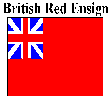
Flags of the American Revolution
 An ensign used by
British naval and merchant ships, the Red Ensign is the British
flag initially favored by the colonists, and all designs of
American flags descended from this banner.
An ensign used by
British naval and merchant ships, the Red Ensign is the British
flag initially favored by the colonists, and all designs of
American flags descended from this banner.
 First used by
George Washington on January 1, 1776, this modification of the
British Red Ensign became in effect the first national flag of
the United States.
First used by
George Washington on January 1, 1776, this modification of the
British Red Ensign became in effect the first national flag of
the United States.
 Rattlesnake flags
were very popular with the colonists, particularly the more
militant ones. This variation of the "Don't Tread on Me" theme
was used by Rhode Island naval figure Esek Hopkins.
Rattlesnake flags
were very popular with the colonists, particularly the more
militant ones. This variation of the "Don't Tread on Me" theme
was used by Rhode Island naval figure Esek Hopkins.
 This is the flag
design that legend says was created by Betsy Ross for George
Washington. Although most modern historians doubt the story, it
has become a vital part of American History
This is the flag
design that legend says was created by Betsy Ross for George
Washington. Although most modern historians doubt the story, it
has become a vital part of American History
 One of the
original 13 star flags, the "Stars and Stripes" was probably the
most commonly used variant.
One of the
original 13 star flags, the "Stars and Stripes" was probably the
most commonly used variant.
 This unique flag
was carried into battle by Vermont troops at the Battle of
Bennington in 1777.
This unique flag
was carried into battle by Vermont troops at the Battle of
Bennington in 1777.
 The American
Stripes flag was flown on American Merchant Ships during the
Revolutionary era.
The American
Stripes flag was flown on American Merchant Ships during the
Revolutionary era.
 This unique flag
was flown at the headquarters of General Washington during most
of the Revolutionary War.
This unique flag
was flown at the headquarters of General Washington during most
of the Revolutionary War.
 This flag was flown
over the Bonhomme Richard, the ship commanded by Captain
John Paul Jones, during his epic duel in the North Sea with the
British frigate the Serapis.
This flag was flown
over the Bonhomme Richard, the ship commanded by Captain
John Paul Jones, during his epic duel in the North Sea with the
British frigate the Serapis.
 This flag was flown
by Colonial troops at the Battle of Guilford Courthouse in North
Carolina in 1781.
This flag was flown
by Colonial troops at the Battle of Guilford Courthouse in North
Carolina in 1781.
 After the addition
of Vermont and Kentucky to the Union in the early 1790s, the
official flag of the United States became the 15 star, 15 stripe
flag. It was used until 1818. This was the flag whose presence
on the flagpole of Fort McHenry in Baltimore, Maryland inspired
Francis Scott Key to write the poem "The Star Spangled Banner."
The poem was later put to music and in 1931 became our national
anthem.
After the addition
of Vermont and Kentucky to the Union in the early 1790s, the
official flag of the United States became the 15 star, 15 stripe
flag. It was used until 1818. This was the flag whose presence
on the flagpole of Fort McHenry in Baltimore, Maryland inspired
Francis Scott Key to write the poem "The Star Spangled Banner."
The poem was later put to music and in 1931 became our national
anthem.


